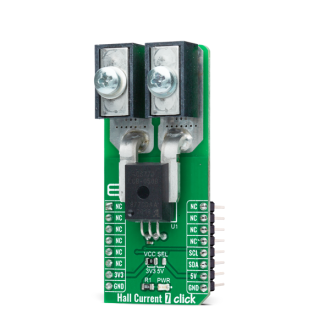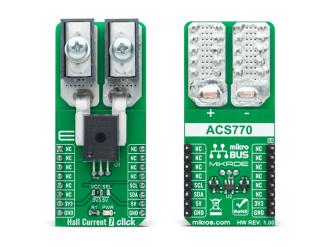
We strongly encourage users to use Package manager for sharing their code on Libstock website, because it boosts your efficiency and leaves the end user with no room for error. [more info]

Rating:
Author: MIKROE
Last Updated: 2020-12-18
Package Version: 1.0.0.0
mikroSDK Library: 1.0.0.0
Category: Current sensor
Downloaded: 3442 times
Not followed.
License: MIT license
Hall Current 7 Click is a compact add-on board that provides economical and precise solutions for AC or DC current sensing.
Do you want to subscribe in order to receive notifications regarding "Hall Current 7 click" changes.
Do you want to unsubscribe in order to stop receiving notifications regarding "Hall Current 7 click" changes.
Do you want to report abuse regarding "Hall Current 7 click".


Library Description
The library covers all the necessary functions that enables the usage of the Hall Current 7 Click board™. It offers reading raw data from output register and calculations for raw output voltage, current and average current passing through the on board Hall Effect Sensor.
Key functions:
uint16_t hallcurrent7_read_voltage ( uint16_t v_ref ); - Function is used to calculate raw output voltage.int16_t hallcurrent7_calc_current ( uint16_t v_ref ); - Function is used to calculate current.int16_t hallcurrent7_avg_current ( uint16_t v_ref ); - Function is used to calculate average current and correct for output error.Examples description
The application is composed of three sections :
void application_task ( )
{
current = hallcurrent7_avg_current( v_ref );
IntToStr( current, log_txt );
mikrobus_logWrite( "Current: ", _LOG_TEXT );
mikrobus_logWrite( log_txt, _LOG_TEXT );
mikrobus_logWrite( "mA", _LOG_LINE );
mikrobus_logWrite( "------------------------", _LOG_LINE );
Delay_ms( 2000 );
}
Other mikroE Libraries used in the example:
Additional notes and informations
Depending on the development board you are using, you may need USB UART click, USB UART 2 click or RS232 click to connect to your PC, for development systems with no UART to USB interface available on the board. The terminal available in all MikroElektronika compilers, or any other terminal application of your choice, can be used to read the message.